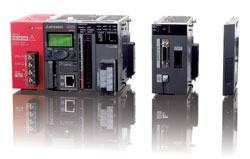
Posted to News on 14th Mar 2012, 19:12
MELSEC L Series PLC is compact, powerful and expandable
Mitsubishi Electric is launching the MELSEC L Series rack-free, modular PLC that fills the gap between the compact MELSEC FX PLC and the iQ platform high-performance modular Process Automation Controller (PAC). The MELSEC L Series controller benefits from much of the power of the iQ PAC, yet it features the compact design and easy expansion of the FX series PLC. Mitsubishi is describing the L Series at "the world's most sophisticated modular PLC" and says that the numerous built-in features will enable machine builders to offer their customers added-value functionality - such as data logging and energy monitoring - without having to buy more hardware.

Suitable for use in mid-size control applications - particularly in machinery - the MELSEC L Series PLC features Mitsubishi's high reliability, user-friendly operation and functional versatility. The rack-free design promotes versatility with a compact form factor, but a good range of features is built into the base CPU to minimise hardware and engineering costs. These features include 24 I/O, a two-channel high-speed counter, two-axis positioning, pulse catch and interrupt functions, data logging, a USB port, Ethernet and CC-Link (master or local station) interfaces, and an SD/SDHC memory card interface for data storage. By making use of CC-Link Safety and compatible products with built-in safety functions, machine builders can avoid the need for additional dedicated safety controllers.
Each MELSEC L Series CPU can be configured with mix-and-match snap-on selectable power supplies, a snap-on display unit, and up to 40 expansion modules, including intelligent modules for motion, positioning, high-speed counting, communications and networking. For example, in addition to the built-in two-axis positioning function, Mitsubishi Electric has developed new high-end four- and 16-axis motion expansion modules using the SSCNET III servo controller network. The MELSEC L Series CPU can accommodate up to four of these high-performance motion modules, each storing up to 600 points of predefined points of positioning data. The motion module supports an external encoder input for axis synchronisation, electronic cam control and automatic cam generation, making it suitable for sophisticated motion applications with up to 16 axes. Furthermore, they are programmed and parameterised using standard function modules conforming to PLCopen Motion Control standards.
The high-speed analogue modules have a conversion speed of just 20us per channel, with a precision of +/-0.1 per cent. Temperature control modules provide highly stable regulation performance, with functions including heating/cooling control, peak current suppression, self-tuning, simultaneous temperature rise, selectable sampling cycle and a temperature input mode.
Expansion modules can be added without the need for a rack or backplane, with each module being clipped to the adjacent module and the whole PLC mounted on DIN rail. Each module - including the CPU and power supply - measures approximately 90mm high by 95mm deep, and the L02CPU, for example, is just 70mm wide.
Powerful built-in functions
The expansion modules provide engineers with a PLC that offers high levels of functionality in some of the most sophisticated network applications, but it is the built-in features and functions that Mitsubishi says define a new paradigm for control at this price-point. The built-in positioning function has a start time of just 30us, a maximum high-speed output of 200k pulses per second, and features such as S-curve acceleration and deceleration.
The built-in data logging function - which is claimed to be unique - provides an easy way to collect information for troubleshooting, energy consumption, performance evaluation and more, with the facility to store data on a standard SD memory card. Data can either be collected on a continuous basis or with trigger buffering to capture data either side of a particular event or error. Because data logging is built in, more data points can be collected so that a more accurate picture of the process can be obtained.
As well as a medium for storing data, the SD memory card slot makes it easy to back up the CPU programs and parameters. Networking and connectivity are simplified through the inclusion of USB, Ethernet and CC-Link interfaces as standard. The built-in CC-Link communications enable the MELSEC L Series PLC to be added to a network as an easy-setup slave, or act as a master for up to 64 of the 1000+ CC-Link field devices currently available.
Built-in Ethernet communication capability provides a simple interface to the enterprise level, seamless peer-to-peer communications and direct connectivity to other devices such as HMIs and vision systems. Logged data can also be retrieved via this port using FTP commands.
Powerful processor
Mitsubishi MELSEC L Series PLCs have a high-performance CPU with a processing speed better than 9.5ns, making it particularly suitable for high-speed motion control applications on machinery. The optional clip-on display features a 16-character, four-line display that delivers error messages in plain English; moreover, the backlighting changes from green to red for quick identification of error conditions.
MELSEC L Series PLCs are fully compatible with iQ Works and GX Works2 software for ease of set-up, configuration and maintenance. GX Works2 in particular focuses on driving down total cost by including features that speed up commissioning, reduce downtime, improve programming productivity and ensure effective security. Any programs written for Mitsubishi FX PLCs can be imported directly and run on the new L Series PLC.
The compact size, easy expandability, networking capabilities and the multitude of built-in high-powered functions make the MELSEC L Series suitable for both standalone machine control and as networked stations in larger applications.
Follow the link for more information about the Mitsubishi MELSEC L Series PLC, for which all modules are available for delivery from stock.
Want the latest machine building news straight to your inbox? Become a MachineBuilding member for free today >>

















